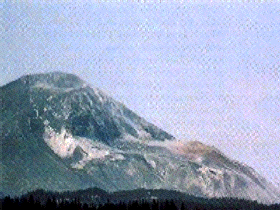| Measurement of Friction Coefficient on a Powder Layer and Fluid Dynamic Study |
|
The 18 May, 1980 eruption of Mount St. Helens induced an unexpected volcanic event (Fig. 1). Masses on the north flank collapsed with a steam blast run with a speed of 35 m/s that traveled for 10 min, reaching a distance of 28 km. Such large-scale and rapid collapse of a part of mountain is called a debris avalanche (Ui, 1987). A debris avalanche deposit is formed by not only grinded rock clasts, but also by large blocks that preserve the stratigrahpy at a source. These blocks are called debris-avalanche blocks, which in the case of Mt. St. Helens has a maximum size of 170 m (Voight et al., 1981). In addition, study of these deposit have revealed that these debris-avalanche blocks had only rotated horizontally and not vertically (Mimura et al., 1982). This observation suggests that a debris-avalanche block does not roll down the slope, but rather slides down above the ground. |
 Fig. 1. View of the debris avalanche of Mt. St. Helens at 8:32 AM on 18 May 1980. This movie consists of a sequence of photographs (Voight, 1981) taken by Keith Ronhholm. Time interval is not exact. |
If this is the case, however, the apparent friction coefficient (ratio of vertical height and horizontal distance of slide path) for the sliding blocks is too small to be explained by conventional models. The friction coefficient for rock is commonly assumed to be about 0.6 (Hsü, 1975), while the apparent friction coefficient observed for the Mt. St. Helens debris avalanche was 0.09 (Voight et al., 1983).
Why does a debris avalanche show such small apparent friction coefficient ?
Many mechanical models have been suggested and discussed to explain the characteristics of debris avalanches, but none has yet succeed (Shaller and Smith-Shaller, 1996).